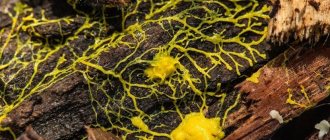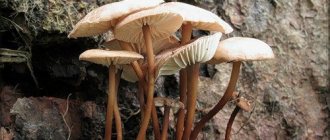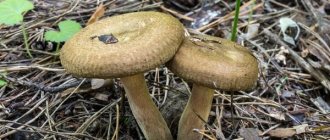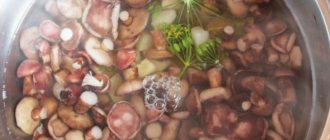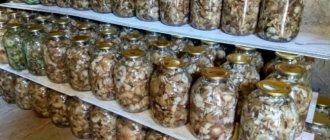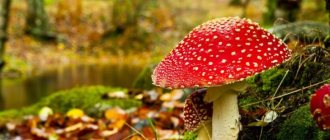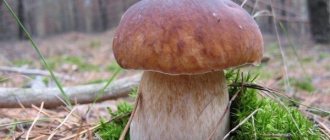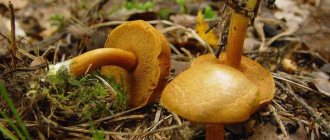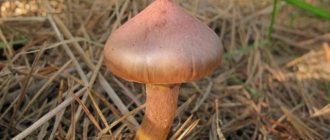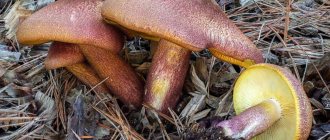Description
To be sure which fruiting body is found, you need to know what the kid mushroom looks like. The slightly cushion-shaped caps of goats are colored from red-ocher to light yellow-brown. They are smooth and hairless in dry weather, slimy after rain. Young specimens have convex caps, old specimens have flat caps, sometimes concave in the center. Their edges are thin. The diameter ranges from 40 to 110 millimeters.
The skin that goes over the edge and tucks into the tubes peels off from the caps when cleaning, like tiny shreds. The tubes of mushrooms that have just broken through the ground are gray-yellow. As the fruiting bodies grow, they turn yellow. Aged mushrooms acquire a brown color. The height of the tubes is 6-10 mm. They usually grow to the legs. They are difficult to separate from the cap flesh.
The legs of mullein are cylindrical, solid, with a thickened bottom. Their height is 30-100 mm, and thickness is 5-20 mm. The top of the longitudinally fibrous legs is yellowish or ocher-rusty, the base is brownish-red.
The cap has dense flesh, colored in white and yellow tones. The flesh of the legs is usually fibrous, brownish-red in color. It turns red when cut. It has a pronounced mushroom smell and pleasant taste. The pulp is endowed with powerful bactericidal properties. It is rich in vitamins, phosphorus, carotene and amino acids.
Features of collection
Goats cannot boast of being particularly popular among mushroom pickers, but if there are no other edible mushrooms nearby, they are also placed in a basket so as not to return from the forest empty-handed. Kids are considered real record holders for the presence of worms and parasites. It also happens that out of a whole group it is impossible to find a single clean one.
When cutting the stem of a fungus, the cut must be carefully examined. If there are no signs of worms in the leg, then pests may be present in the flesh of the cap. If there is any doubt, the mushroom cap should also be trimmed to ensure it is clean and fit for consumption. It is not advisable to take old goats home because they can easily spoil in just a few hours.
Are there false kids?
Grebes do not disguise themselves as goats. False goat mushrooms do not exist in nature. The only mushrooms that mullein resemble are pepper butter and flywheels. A non-removable skin and the absence of a cuff on a thinner and more graceful stalk are characteristic features of baby goat mushrooms, which make it possible to distinguish them from butter mushrooms. The underside of the caps of the goats looks like a porous sponge. It is this that prevents them from being confused with flywheels.
Value
Baby goat mushrooms are champions in worminess. It’s a common sight to see a huge family of dry butternut squash on the forest carpet, but there’s practically nothing to put in the basket. When harvesting fruiting bodies, a clean cut is usually visible. But this does not guarantee that the cap will be free of worms. In half of the mushrooms from the entire family it will certainly turn out to be wormy. When collecting mullein, mushroom pickers are often disappointed in them and stop collecting.
The chemical composition of goats is rich. Proteins are saturated with essential amino acids: methionine, tryptophan, arginine, histidine. But they are too poorly absorbed by the body. No more than 70% of the protein contained in dry butter is processed in the gastrointestinal tract.
The fatty substances found in these mushrooms are 95% digestible. A representative of carbohydrates is glycogen. It is easily absorbed by the body. B vitamins and carotene are concentrated in goats. They are enriched with vitamin D, phosphorus and folic acid.
Usage
Wild goat mushrooms are quite edible. They are consumed fresh and stored for future use. They are suitable for pickling, drying and freezing. When dried, the flesh of the mushrooms darkens. Dried goats make an excellent mushroom powder. When cooked (cooking and frying), they turn purple.
| Name: | Butter |
| Type: | Edible |
There may be several reasons why boletus turned purple after cooking. To understand what the color change means and whether something can be done, you need to understand the characteristics of these mushrooms.
Edibility of goat
Kozlyak is an edible mushroom that is consumed fresh (after boiling for 15 minutes), salted or pickled. Dried goat mushroom is also very popular.
To dry the goat, young, undamaged mushrooms are wiped dry with a rag. There is no need to wash them, as they do not dry well. The mushroom cap is cut open to check for worms or any other damage. In hot weather, the goat is dried in the sun by stringing mushrooms on a string. In damp weather, dry the mushrooms in the oven (temperature no higher than 70 °C). When drying, fresh air must be supplied to the mushrooms to remove the moisture that the mushrooms release.
Mushroom powder is prepared from dried goat. To do this, dry mushrooms are either ground in a coffee grinder or pounded in a mortar. Goat mushroom powder is used to season meat, rice dishes and sauces. The aroma of these mushrooms intensifies when dried, so for use in cooking, minimal amounts of mushroom powder are needed.
Why do boletus turn purple when cooked?
Every mushroom picker should know that this variety of mushrooms usually does not change color after heat treatment. During the boiling process, it is not characterized by the appearance of blue, lilac, or brown shades.
If the butter dish turns purple during cooking, this indicates that the cooking method was incorrectly chosen. The stems and caps darken from too much heat treatment. When heated for a long time together with water, vegetable protein is destroyed, and boiled mushroom raw materials develop an unusual blue color. Such a change may also depend on the area of growth, when the composition of the soil and illumination can affect the course of chemical reactions during heat treatment.
Pickled boletus turns purple when cooked due to numerous additives in the form of spices, garlic, onion, and pepper. To avoid this, you need to boil the product several times, and be sure to drain the first water. It is recommended to add vinegar and a pinch of citric acid to the marinade.
Other mushrooms are the first reason why boletus darkens during heat treatment
The main reason for the sudden change in color of mushrooms to dark or purple after cooking is the inclusion of other species in the basket that are similar in appearance to boletus. Among the doppelgängers we can distinguish kids (goats, or reshetniks), which are easily confused when collected. This is also an edible variety, which tastes almost no different from the “original”.
Other forest plants also have the ability to change color, including:
- Mosswort
- Grabovik
False boletus turns black already at the cleaning stage. They differ from real representatives by a different structure of the cap: under it there is not a sponge, but plates.
Violation of cooking rules is the second reason why the butter turned purple
The oiler turns purple due to improper processing technology. In order for the product to retain its original appearance after boiling, you need to prepare it following simple rules:
- large ripe fruits are cleared of film;
- legs and caps are brought to a boil in clean water;
- boil for no more than 5 – 10 minutes;
- Drain the mushroom mass in a colander;
- pour salted water, after boiling, cook for 15 - 25 minutes, depending on the size of the fruit.
Recipe
Many lovers of quiet hunting, after bringing home a harvest, wonder: goat mushroom - what to do with it? There are a lot of cooking recipes: Ivanchiki can be boiled, fried, pickled, frozen, made into soup, or made delicious in the oven. Just before that, you should find out how to properly clean and prepare cow mushroom.
Primary processing
First you need to carefully sort through the mushrooms brought from the forest to prepare them for cleaning. It often happens that almost all fireweeds are worm-eaten; worms and other insects love this mushroom. Next, you need to cut off the tip of the stem of the fruiting body, cut the mushroom lengthwise to once again make sure that there are no worm spots. Then the goats are soaked in water for 15-20 minutes to remove sand and forest debris. Rinse the goats and continue cooking according to the recipe.
Cooking
The peeled and washed fruiting bodies should be filled with cold water and the container should be put on gas, turn on medium heat and bring to a boil. Then this liquid is drained, filled with fresh liquid, and added with salt at the rate of 1 tsp. salt per 1 liter of water and cook for 15 minutes. After this, the goats are washed under running cool water, drained in a colander and the moisture is allowed to escape.
Important! When cooked, the goat mushroom turns blue and becomes violet-purple. Do not be afraid of this color, as this is a natural property of this species.
Marinating with vinegar at home
One of the best ways to prepare mushrooms for the winter is pickling. Find out how to pickle baby goats for the winter in jars; this process does not take much time.
Ingredients for the cold method:
- goats – 1 kg;
- salt - 3 tsp;
- sugar - 2 tsp;
- garlic - 2 cloves;
- cloves - 3 pcs.;
- black pepper - a few peas;
- bay leaf – 2 pcs.;
- dry dill;
- vinegar 9% - 3 tbsp. l.
How to pickle baby goat mushrooms for the winter in jars, a simple recipe:
- Wash and clean the fireweeds. Cut each fruit body into several pieces to ensure there are no wormholes or rotten spots.
- Boil the mushrooms for 15 minutes in salted water and rinse again.
- Prepare the marinade: pour water into a container, add salt, sugar, spices and let the mixture boil.
- Place the goats in a container and cook them over low heat for 15 minutes.
- Remove the pan from the stove, add vinegar.
- Place the pickling mixture in sterile jars and seal them with lids.
Freezing
Housewives often ask: can goat be frozen? Like any other types of mushrooms, fireweeds can be frozen for the winter. They do not lose their beneficial properties, and after defrosting they behave well in soups, stir-fries, stews, even fried.
To freeze goats for the winter, you need to wash, soak and cut each fruiting body into several pieces. Next, the mushrooms are boiled in salted water and washed again.
Place in a colander so that each fruit is as dry as possible and place in portioned containers. Plastic dishes, bowls, etc. can be used as containers for freezing.
Important! It is better to put 100–200 grams of mushrooms in one serving container, so that after freezing you do not have to heat treat the goats again. It will only worsen their nutritional quality.
Frying
If you don't know how to fry goat mushroom, use the following recipe. At the end of cooking, you can add low-fat sour cream or cream to the dish and sprinkle with chopped herbs. Some mushroom lovers even prepare fried goats for the winter, and then use them in various treats.
Ingredients:
- kids – 1 kg;
- onions – 2 pcs.;
- salt - to taste;
- vegetable oil – 60 ml;
- black pepper, bay leaf.
Goat - how to cook fried:
- Peel, soak and boil the willow mushrooms in salted water. Before carrying out these procedures, it is important not to forget to cut each fruiting body into several parts.
- Peel, cut into small cubes and fry the onion in vegetable oil.
- Place the mushrooms in a colander to drain all excess liquid.
- Add the goats to the pan with the onions, add spices, add salt, and fry for 15 minutes until cooked.
Pickling
This recipe is designed for 1 kg of goats, but this method can very quickly process a large harvest! Before salting goat mushrooms, you need to prepare aromatic herbs: tarragon (tarragon), currant and cherry leaves, dill umbrellas, garlic, cloves, horseradish root.
Ingredients:
- goats – 1 kg;
- salt for boiling - teaspoon;
- salt for pickling – 60 g;
- garlic – 5 cloves;
- dried dill – 5 g (can be replaced with 30 grams of fresh);
- tarragon - a pinch;
- horseradish (leaves) - 1–2 pcs.
Kozlyak - pickling:
- Clean the mullein, remove forest debris and pine needles from them.
- Place the mushrooms in a deep container, fill with water, and put on fire.
- Add salt and simmer for half an hour from the moment the water boils.
- Rinse the fruits and place in a colander to drain.
- Prepare a wooden barrel or enamel container and scald with boiling water.
- Place goats in it in layers, sprinkling each layer with salt and spices.
- Peel the garlic, cut it into slices, and place it on top of the pickling. Do the same with dried dill.
- Cover the workpiece with oppression, leave it in a cool place for 3 days, then move it to the basement or cellar. Salted goats can be eaten within a week.
Drying
There are several ways to dry goats:
- String it on a thread and hang it in a shady place.
- Fresh mushrooms can be wiped with a rag and cut into thin slices. Then the goats are laid out on a tray and placed in the sun or in another well-ventilated place. In 2-3 days they will be ready.
- You can speed up the drying process in the oven. To do this, cut the fruiting bodies into thin slices, place them on a baking sheet, which must first be lined with parchment and put in the oven for 4–5 hours. The oven temperature should be no more than 50C.
Reference! Dried goats can be ground into powder and used as a flavoring in the preparation of soups, sauces, and gravies.
Canning for the winter in jars
Try making marinated goats with mustard. Not only is it a natural preservative, but it also perfectly complements the taste of mushrooms.
Ingredients:
- goats – 4 kg;
- dry dill – 8 pcs.;
- black peppercorns – 12 pcs.;
- allspice – 8 pcs.;
- bay leaf – 10 pcs.;
- mustard seeds – 1 tbsp. l.;
- sugar – 2 tsp;
- salt -2 tbsp. l.;
- vinegar – 100 ml.
How to quickly marinate boletus for the winter:
- Mushrooms must be thoroughly cleaned and soaked to remove sand and forest debris. Then the goats should be boiled for 15 minutes.
- Place the fruits in a deep container, fill with water. Bring to a boil, cook for half an hour, constantly skimming off the foam.
- At the end of cooking you need to add all the spices and salt. Pour in vinegar.
- Cook for another 15 minutes.
- Place the pickling mixture in sterile jars and seal.
- Store in a cool place.
What to do to prevent boletus from turning black
It is especially unpleasant when the mushroom mass darkens in the jar after salting. The finished product does not look aesthetically pleasing, and the appearance of the dish is not appetizing. Experienced foresters advise adding a little citric acid and vinegar to the marinade. Before serving the roast, sprinkle the dish with lemon juice. This will add a subtle sour taste and preserve the beautiful appearance of the butter.
How to cook butter without turning brown
It is recommended to boil the product before any further use:
- before frying;
- freezing;
- slicing for salads;
- for soup.
To prevent the butter from darkening during cooking, there are several tips for the housewife:
- Mushroom raw materials should be kept in boiling water for no more than 30 minutes.
- Before frying, boiling time should be reduced to 15 minutes.
- It is important to first defrost the frozen preparation, and then cook it in the same way as fresh mushrooms.
- Before freezing, the butter must be boiled a little, dried, and put into bags. It is permissible to harvest raw fruits.
- When preparing soup, the first water must be drained, and the base of the dish will be the following broth. Boiling time should not exceed 30 minutes.
- When cooking, add 1 tsp. citric acid.
- It is recommended to simmer butter in a slow cooker for about 40 minutes.
There is no need to worry if the butter mushrooms turn purple after cooking: all the taste characteristics of the mushrooms will remain unchanged, and the dish will turn out just as appetizing as usual.
Characteristics, composition and description of the mushroom
The goat is a tubular mushroom of the genus Suillus (Oil Can), family Suillaceae (Oil Can), order Boletales (Boletaceae). It also has popular names: Reshetnyak, Dry butterdish, Goat mushroom, Ivanchik, Korovik, Cow mushroom, Mullein. Latin names: Suillus bovinus, Boletus bovinus.
The diameter of the cow's cap varies from 4 to 12 cm. It has a brown, reddish or brown color, sometimes with a reddish tint. At a young age it is slightly swollen, but over time it straightens and becomes even. Smooth to the touch, without cracks or bumps. The skin fits tightly to the cap and is difficult to remove.
The hymenophore (lower part of the cap) is tubular, yellowish or brownish in color, slightly lighter than the cap and stalk. The tubular layer is descending, the pores are yellowish. The spore powder is light brown and olive yellow.
Goat mushrooms have dense, elastic flesh, which becomes rubbery over time. The color of the pulp is pale yellow or light yellow. In the stem it is reddish, brownish, and when cut it turns red or pink. It does not have a pronounced odor, the taste is weak, it gives off a sour taste.
Important! After heat treatment, the flesh of the goat turns pinkish-purple.
The leg reaches a height of 4-10 cm, its thickness is 1-2 cm. It has a solid cylindrical shape, often curved, tapering downward. Its surface is smooth, matte, the color matches the cap or is slightly lighter. The base is yellow.
A little history
German traveler and botanist Otto Kunze first described goat's mushrooms and gave the species a binomial name in 1898.
How to assemble a grate correctly?
The summer months of July to August and early September are when kid production peaks. By October there are very few of them. It is advisable to choose young fruiting bodies and avoid old ones, as they accumulate harmful components. It is especially dangerous to pick fruiting bodies along highways and in industrial zones near operating enterprises. The goats absorb radioactive substances and exhaust gases.
When assembling a grate, you need to take only strong, intact specimens. Listen to their smell (it should be a pleasant mushroom smell), and avoid outwardly unfamiliar mushrooms - those with a strange hue. Kids, unfortunately, are kind of record holders for worms. Both caps and legs can be damaged. It is advisable to immediately cut off and throw away the wormy parts of the bogworms.
For beginner mushroom pickers, an overview of the “Kat Kids” mushrooms is provided in the video below:
Time and place of fruiting
The fireweed mushroom forms mycorrhiza with pine and grows singly or in large groups. For habitat it prefers acidic nutrient soils, damp places, grows in swamps or on roadsides. The lattice mushroom is widespread in the northern temperate zone of Europe, the European part of Russia, the North Caucasus, the Urals, Siberia, and the Far East.
Reference! The name “goat’s mushroom” (the mushroom is also called “cow’s mushroom”) was given to the mushroom for its place of growth - it is easy to find in meadows where cattle graze.
Fkusnofacts
Where do milk mushrooms grow, their types and description (+26 photos)
How to clean baby goats
First of all, cut off the tip of the leg and check the kids for worms. Cut the stem and cap in half, cutting out possible wormy spots. Soak the kids in water for 15 minutes to remove forest debris. Then wash the mushrooms and start cooking.
Fried goats in sour cream
1. Boil mushrooms for 15 minutes in a small amount of water, then drain the water and rinse the mushrooms. 2. Fry the onion, add mushrooms, fry for 5 minutes. 3. Add sour cream, salt to taste, dill, mix.
— Name
The “goat’s kid” (also called the “cow’s” mushroom) got the mushroom for its place of growth - it is easy to find in meadows where cattle graze.
— Baby goat mushrooms are very reminiscent of boletus
and enter the genus oil. These are relatively small mushrooms with a cap diameter of 3-12 centimeters, the color of the cap is from marsh beige to ocher, under the cap there is a porous surface resembling a sponge. It is easy to distinguish goat kids from an oiler if you look under the hat. A baby goat will always have an ocher tint to its color.
— When cut, the caps of the kids turn pink or red, and may turn red
. There is no need to be afraid of this, this is normal. And this is very original for mushroom soup.
— Search
kids are recommended near pine trees, season from August to September.
— The inedible pepper mushroom is very similar to baby goats. Distinguish
From a goat, a pepper mushroom can be identified by the color of the porosity under the cap: a goat’s color is olive-brown, without shades of red, but a pepper mushroom is always reddish.
- Can be prepared
kids, freezing them or drying them for the winter.
— Peculiarity
kids - they do not have a mushroom aroma at all.
— It is not recommended to salt goats, because when salted they can taste bitter.
Growing at home and in the country
Since cowweed is a mycorrhizal fungus and grows close to coniferous trees, therefore, it is very desirable that young pine, cedar or spruce grow on the site.
Important! Goats, like their closest relatives, cannot live without a patron tree.
Cultivation of goat kids occurs in several stages:
- Soil preparation. In the selected area (preferably in partial shade), the top soil layer is removed. Since the correct growing technology requires the formation of several layers of soil, plant materials, for example, chopped wood, grass, foliage, and pine needles are placed in the first layer. For the second layer, you need to use soil collected from the areas where the kids grow, then it will have an acid-base balance that is as close as possible to the optimal one. You can take ordinary garden soil. If necessary, humus should be added to it. Baby goat mycelium is sown on the prepared soil.
- Inoculation of mycelium. You can purchase it in specialized stores or prepare it yourself from old mushroom caps. To do this, you need to collect adult, overripe specimens and mix them with a substrate prepared from a mixture of pine sawdust and peat. The dried substrate is laid out to half a three-liter jar, compacted and filled with a nutrient solution (one and a half liters will be needed). It is not difficult to prepare: you need to take a teaspoon of sugar and the same amount of yeast for 1 liter of water. The solution is brought to a boil and peat is poured over it. Fill the remaining space inside the jar with dried sawdust and cover it with a tight lid.
- Sowing mycelium. The entire substrate is evenly distributed in a thin layer near the trees, covered with a layer of foliage or grass, and sprinkled with garden soil on top. It is very important to constantly maintain an optimal level of moisture in the soil.
- Fruiting will begin a year after planting and will continue for 15 years. In the first year, you should not count on a bountiful harvest, since the mycelium develops over 5–7 years. But in subsequent years, the harvest volume will increase significantly.
False doubles
The goat's main similar and inedible counterpart is the pepper mushroom, or Pepper Butterfly (Chalciporus piperatus).
Pay attention to their differences in the photo. The diameter of its cap is 2–7 cm; it is rounded-convex in a young specimen, becoming flat or prostrate with age. The surface is smooth, slightly sticky, and shines in dry weather. The color of the cap is light brown, dark orange, orange-red. The skin does not come off easily. The flesh of the pepper butterfly is loose and yellowish in color. It is yellow at the stem, turns red when cut, and has a characteristic spicy peppery taste.
The stem is cylindrical, curved, tapering downward, solid, dense, brittle, the color matches the cap. Pepper butterfly grows in coniferous forests. Its distribution range includes the northern temperate zone of Europe, the European part of Russia, as well as the North Caucasus, the Urals, Siberia, and the Far East. Grows singly or in small groups.
Pepper butter is a small, inedible mushroom that is sometimes used as a spicy seasoning instead of pepper. This is what gave it its name.
Evaluation of taste qualities, medicinal properties, benefits and possible harm
Butterfly is an edible mushroom, it is consumed fried, salted and pickled. Very often it is dried.
Reference! In folk medicine, goat is considered an effective remedy for the treatment of polyarthritis.
The goat mushroom, the benefits and harms of which will be discussed further, has not found widespread use in pharmaceuticals. Nevertheless, traditional healers claim that it has a number of medicinal properties:
- Improves vision. The mushroom contains selenium and polyunsaturated fatty acids, which prevent the occurrence of cataracts and retinal detachment.
- Slows down the aging of the body due to the presence of antioxidant substances. With regular but moderate use of lattice, the condition of the skin improves and sagging goes away.
- Relieves inflammation, normalizes lymph flow, water balance, helps in the treatment of sore throat, bronchitis.
- Activates the immune system, reducing the likelihood of developing seasonal viral diseases, especially during the peak of epidemics.
- Prevents the appearance of neoplasms, promotes the removal of harmful compounds, waste, and toxins from the body.
- Normalizes the functioning of the gastrointestinal tract due to the presence of dietary fiber, ash and water.
- Helps with weight loss, as it accelerates metabolic processes, removes toxins, and quickly satisfies the feeling of hunger.
Reference! It is believed that goat is most useful when salted, although drying also fully preserves the entire range of beneficial substances.
It must be remembered that the consumption of goat is prohibited for children under 9 years of age, pregnant and lactating women, people with pathologies of the kidneys, liver, and bile ducts. In addition, you need to know that the goat is very sensitive to radiation, and immediately absorbs toxins and poisonous substances from the air. Therefore, this species cannot be collected near industrial enterprises and roads.
Application
Baby goat mushrooms, photos and descriptions of which are presented in the article, are very often used both in cooking and in medicine. First of all, the popularity of this mushroom is due to its beneficial properties, since trellises do not have a pronounced taste. However, with proper processing, this plant can be used to obtain both very tasty and nutritious dishes, as well as quite useful medicines for many ailments.
In cooking
Baby goats are suitable for preparing various winter preparations: this product can be pickled, salted, or dried. So, from dry baby goat powder you can make gravy, puree soups or various sauces. In addition, young mushrooms are used to make jam in orange syrup. You can also make various casseroles or pies from bogwort.
In medicine
Due to the presence of nebularin in goat mushroom, this mushroom has a very strong antimicrobial effect. In folk medicine, this product is used in the following cases:
- if there are bruises or pain in the joints;
- for herpes, purulent wounds and other types of infections;
- to boost immunity;
- for radiculitis, osteochondrosis or gout;
- to relieve skin irritation and eliminate flaking.
For all this, various alcohol extracts, cosmetic lotions, tinctures and compresses can be prepared from goat kids.
